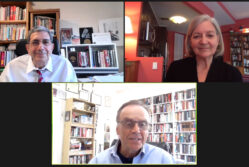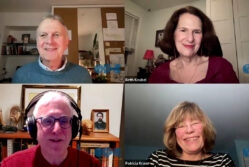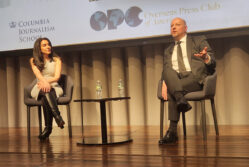Event Coverage Highlight

OPC Best Cartoon Award Winners Discuss Creative Process and Misconceptions About Their Work
by Chad Bouchard
Political cartoonists who are past winners of the OPC’s Best Cartoon awards discussed their creative process, their personal “red lines,” and misconceptions of their work during a panel hosted by the OPC on May 19.
The event marked the latest installment of the OPC’s “How I Did It” series about journalists’ work, featuring past OPC Best Cartoon Award winners Kevin (KAL) Kallaugher, the editorial cartoonist for The Economist, The Baltimore Sun, and the online newsletter Counterpoint; Rob Rogers, who currently draws political cartoons for Counterpoint.com and Tinyview.com and previously worked for 25 years for the Pittsburgh Post-Gazette; and Patrick Chappatte, editorial cartoonist and comics reporter working for The Boston Globe, Der Spiegel in Germany, Le Canard Enchaîné in France, and Le Temps and NZZ am Sonntag in Switzerland.
Kallaugher most recently won the OPC’s Best Cartoon award for his work in 2020. He kicked off the program with a sampling of Chappatte’s cartoons and a discussion of his process in creating each one.
The images Chappatte selected to showcase included a recent cartoon of a Russian tank leaving a trail of bodies in its tracks, and another depicting a spherical shadow rimmed by the characteristic spikes of a COVID-19 cell as it eclipses the Earth.
“That’s a cartoon that sums up a long period of our time, a period that was shared by all of us on the same planet,” he said. “It’s just an image of the eclipse of our lives that this long crisis was – a time that was at the same time very personal and felt all around the world.”
Chappatte added that he is often most satisfied with images that are visually simple.
“A visual idea synthesizes things in a second. Your gut understands it even before your brain processes it. And the beauty of a cartoon without words is that it can jump borders,” he said.
Chappatte was previously a cartoonist for the International Herald Tribune and The New York Times for 20 years. Chappatte won the OPC’s Best Cartoon Awards for his work in The New York Times in 2018 and 2015, and won the 2011 award for cartoons in the International Herald Tribune.
Rogers, who won the 2012 Best Cartoon Award for his work in the Pittsburgh Post-Gazette and before that won the award for work in 1999, discussed a four-panel cartoon he drew depicting destruction and casualties from Russia’s intervention in Syria’s Civil War, with an onlooker declaring that “the world must act before it’s too late.”
“Cartoonists are just like everybody else in the world,” he said. “We feel helpless to not be able to do anything. So this is what we can do, is to draw more attention to an issue and point out the inhumanities that are happening.”
Responding to an audience question about taboo subjects and personal boundaries in their work, Kallaugher, who has published more than 10,000 cartoons and 150 magazine covers during a career that spans four decades, said there are some topics where he treads carefully.
“We are commentators, but we want to be effective commentators. And to be effective, we have to engage an audience. And if we do imagery – often the problems cartoonists get into is imagery – if we do inflammatory imagery, we can actually lose the conversation.”
Chappatte said he avoids topics where he doesn’t think he can add much to the conversation with a cartoon. “It’s hard to do cartoons on sad news or on good news. Everything in between is good material, I guess.”
Kallaugher asked his colleagues what they see as common misconceptions about the profession. Chappatte said many people only see the humorous side of cartoons, but he finds the work interesting because it has the ability to provoke a full range of emotions with cartoons.
“To me the definition of a good cartoon is when you manage to strike a balance between the depth of the content and the lightness of the form,” he said.
Rogers said he finds many people think editors assign topics and ideas to cartoonists, when in fact it is the cartoonist’s job to generate ideas and comment on current affairs. Kallaugher described the role of political cartoonists and their relationship to journalism as the “decathlon athletes” of their form.
“Really we wear many hats,” he said. “The first thing we are – we’re journalists first, then we’re columnists, we’re doing commentary on the news, then we’re satirists, we’re using our commentary and adding humor to it, and then we’re artists at the end of it.”
“We are strange animals,” Chappatte added.
Click the window below to watch a playlist of clips from the program.



